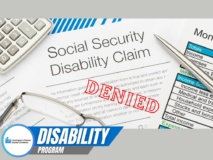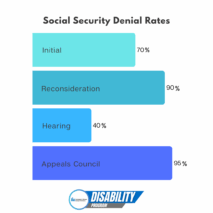The Social Security Disability Process

Introduction to the Social Security Process
Most Americans do not know how difficult it is to apply for Social Security Disability. The truth? It is often a daunting and overwhelming process. That’s right, I said process. It is incorrect to think applying for Social Security Disability (SSDI) or Supplemental Security Income (SSI) is little more than completing an application. Applying for either Social Security disability benefit is a multistep process.
Why is it important to learn about the process?
Understanding ALL of the steps in the application process will help make the process less daunting. Additionally, it will help improve your chances of getting approved. Approximately 70% of initial applications are DENIED. Many of these claims are denied because people do not understand the application process so they don’t follow Social Security’s rules.

How many steps are in the process?
7-10 steps. There will be more steps in the process if your claim is denied.
What steps are in the process?
- 1. Preparing the Application
- 2. Completing and Submitting the Application
- 3. Confirming Compassionate Allowance Flag
- 4. Submitting Medical Evidence
- 5. Following-up with Social Security
- 6. Completing Additional SSA forms
- 7. Social Security Doctor’s Appointments
- 8. Understanding Approval/Denial Letter
- 9. Appealing a Denial
- 10. Social Security Case Review
When does the process start?
The Social Security disability process starts long before you ever contact Social Security to start the application. First, and foremost, it starts with a diagnosis. For some, its start with a positive gene test. But, for many, it starts with a clinical Huntington’s Disease diagnosis (generally, medical confirmation by a neurologist), and regular medical care. You cannot medically be approved for Social Security or any other disability benefit if you do not have:
- An official clinical diagnosis (the gene test is not enough)
- Medical records showing your diagnosis and symptoms
- Documentation of the limitations caused by your HD symptoms
Second, it starts with the acknowledgement and the plan to stop working. You will not be found disabled by Social Security or any other disability benefit program if you are still working full time.
What comes next?
Taking the time to learn about the SSA process and utilizing all of the amazing HDSA Disability Program Resources.
Contact Us
If you have questions, you can always Ask Allison!

